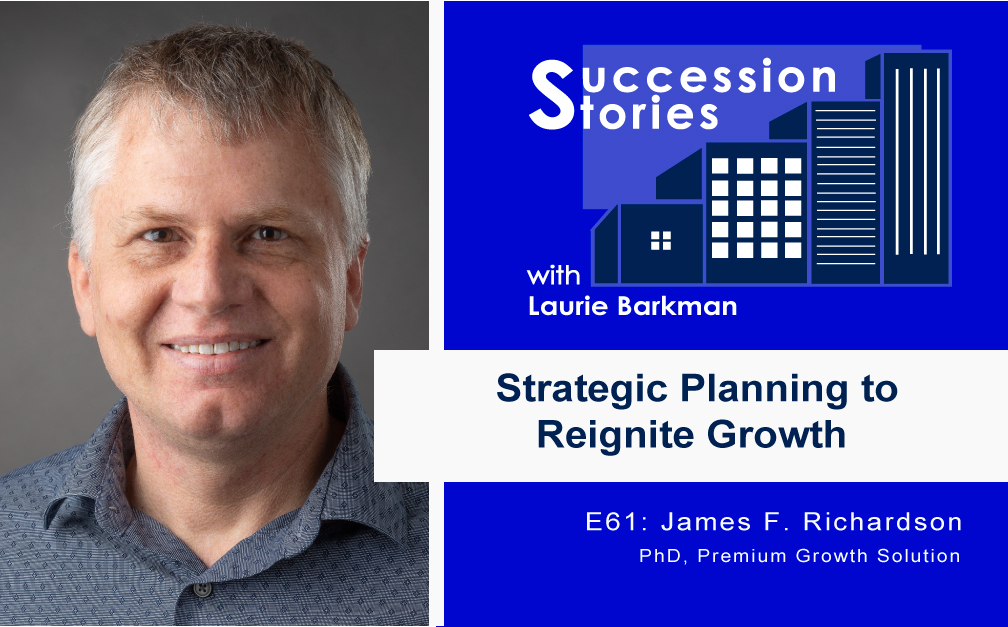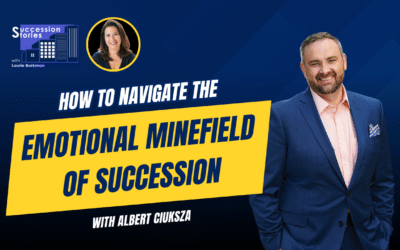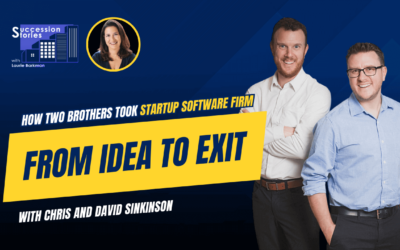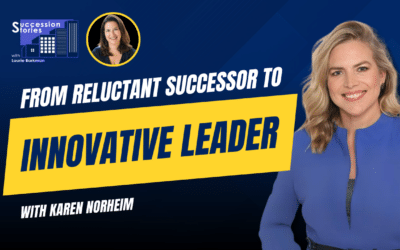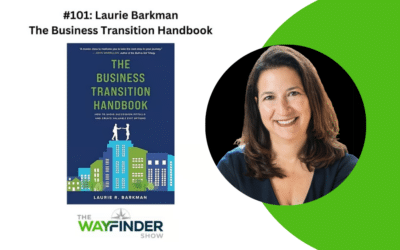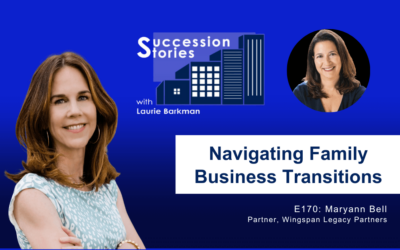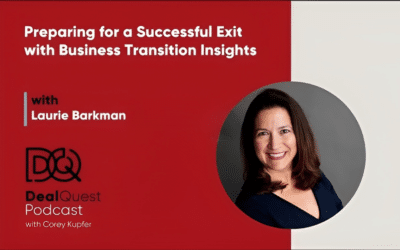Reignite growth in your company by doing this one thing: Be curious. Rethink your assumptions about why people buy from you– and why they don’t. On this episode, Laurie Barkman talks with Dr. James Richardson, a professionally trained cultural anthropologist turned business strategist, about the importance of customer research. Understanding customer needs is a critical part of strategic planning and differentiating your business in an increasingly competitive market.
Listen in to learn more about:
- Approaching innovation from a customer-focused perspective
- Discovering potential product category issues through interaction with consumers
- Listening to consumers and driving innovation to address their concerns
- The 4Ps of strategic planning
Show Links:
Podcast website: SuccessionStories.com
Episode Transcript
Laurie Barkman:
Dr. James Richardson, thanks so much for joining me this week on Succession Stories. You had reached out to me to come on the show, which I always love. It’s always great to hear from a fan and people who think they can collaborate in an interesting way for the benefit of the audience. I’m really excited about today’s episode, because you have so much experience in working with startups, and how those startups ultimately and strategically look to get either acquired or partner with larger, more well established companies. Because our core audience here for Succession Stories are probably more of the latter category, more well established, I thought it’d be really interesting as a way to continue this innovation conversation that I’ve been having with multiple guests about how large companies can get back to their entrepreneurial roots and I’m really excited to talk to you because I think you’re going to bring a really cool perspective. So welcome.
Dr. James Richardson:
Thank you, Laurie. Yeah, your show attracted me because I think it’s gonna help me reach a different audience than I normally talk to, so thank you again
Laurie Barkman:
Yeah, you’re normally talking to CPGs, so we’re going to use that acronym which stands for what?
Dr. James Richardson:
Consumer packaged goods or everything sold at Target.
Laurie Barkman:
Everything sold at Target and you work with a lot of startup CPG companies. Why don’t you tell us a little bit about your background, and how you got involved in working with CPG companies, startups in particular?
Dr. James Richardson:
Okay, I’ll give you the two minute version. Here we go. You can time me. I began as an academic anthropologist. So I left academia about 20-22 years ago, for a variety of reasons. I went into market research and my first client at our company was Whole Foods Market. In fact, we had a retainer with the management team. Because it was small, and they were pretty hands on, at least Walter Rob was at the time, so I got thrown into the deep end of emerging food and beverage trends in the United States related to health, wellness, organic, all the weird and wacky stuff, the left coast stuff, as it was still perceived back then.
So I immersed myself through consumer research for my clients, and traveled the country and got really into emerging trends, behavioral trends; why do people adopt an organic food diet, for example. That was my entry to the business. It was a mix of social science research with a marketing strategy component too later on in my career.
I started working with bigger public firms that were interested in renovating the brands that they had, because they were slowing down. This would be like the late 2000s. Companies are trying to do innovation way off of the normal core innovation that their internal teams were used to doing, ie pseudo entrepreneurial innovation. That basically came to a head with a project I did about six, seven years ago, for Coca Cola venturing in emerging brands, where they’d set up an incubator that made minority investments and tried to boost small brands that they acquired.
Their success rate with hit or miss. Actually, the most successful Coca Cola VEB brand they’ve ever had has been Fairlife milk, which was a joint venture with an entrepreneur. Funny thing, when they tried to do it, when they tried to buy little startups it didn’t work, when they tried to partner or try to do it themselves it didn’t work.
I worked a lot at the end of my big company consulting career with corporate strategy and other folks trying to figure out, could they create units inside that would do this stuff and we can talk about that a little bit, but I went out on my own to work with startups, because I had done some data science research and the company was gracious enough to let me use that for my new company, because they didn’t do anything with it.
Laurie Barkman:
Yeah. Well, that’s always a challenge. I think it’s a challenge for larger, well established companies to have an innovation process and some, the likes of Coca Cola, have been at this for a while, whether they’re creating their own internal brands, or whether they’re looking to partner as you mentioned, a couple of examples. For privately held companies who may have been feeling disruption for a while – and disruption and many people think it’s because of technology, and I believe that it’s actually because of the customer – the customer’s tastes are changing, and maybe there’s some market dynamics that have exacerbated those tastes or practices to change.Companies that are looking at themselves, taking a really hard look, I think 2020 has forced a lot of changes in companies, whether it’s their personnel, practices and work from home and those types of things that we all think about, and we’re impacted by, but also how they go to market, and I want to talk about the customer in this sense.
One of the things I really liked about your book – which I read and it’s called Ramping Your Brand – one of the things I really liked about it, I want to focus on demand driven growth, which is this notion of consumer pull – consumers pulling a company towards a certain direction. Let’s talk about that for a moment. What does that mean to you?
Dr. James Richardson:
What it means to me is that the product design itself in the core UPC, as they say, in my world, it unconsciously has unlocked something that was sort of buried underneath the conscious thought stream of the ordinary consumer, but was actually really powerful. It was either an unsolved problem, you could call it an unmet need, you could call it a latent desire. In my book, I talk about outcomes as what you’re really designing for, and when you get the most successful early stage CPG brands that I tend to work with, or advise, what they’ve got is this original innovation, which is very conceptually simple, and that’s one reason why it is able to become memorable very quickly with a otherwise pretty busy human brain, in modern urban life.
It taps into either a problem or it basically redefines the problem and how to solve it, and it does this very quickly. It does it unconsciously through symbolism and through the usage of it. Sometimes it’s the sensory experience or the usage of the product which finally gets people over the hump where they’re like, “Oh, wow.”
Here’s an example. One of the fastest growing brands no one’s ever really talked about in the business world in the last 10 years was a tiny little innovation from a private label pizza manufacturer up in Wisconsin, Milwaukee, to be exact. He has this big private label business, he has plants, and he invented a chicken pita pocket sandwich that microwaves in 55 seconds from ‘frozen’. It was the fastest microwave thermal runaway product on the market when it came out.
Laurie Barkman:
I think 55 seconds. I think I’m gonna get rubber chicken. Not a rubber chicken.
Dr. James Richardson:
Yep, it’s yummy.
Laurie Barkman:
So the innovation was the speed?
Dr. James Richardson:
The innovation was simply the mechanics of his plant. He was willing to retool his plant and take a risk on that retooling to make this pita pocket sandwich and stick a half of a chicken breast inside that had been pre-cooked and pre-fried, and it was that willingness to retool his plant, to do something that nobody else in the entire North American infrastructure could do, including the big guys. To chase something that was really simple, which is that if you talk to mothers and hang out with them, listeners, especially the male listening, you will learn that the difference between two and a half minutes and 60 seconds with a screaming seven year old in your face is massively consequential.
Laurie Barkman:
Yeah, very high utility to make that child stop screaming.
Dr. James Richardson:
The cultural insight there is that time is always relative to the context in which you’re perceiving time. This is not a physics class. This is cultural anthropology 101 and it’s neuroscience. When people get really stressed, time slows down. That’s why you’ll hear mothers talk about, “Oh my God, I can’t believe it. I made it to the end of the day today.” Because they probably had constant fights with their kids and to them, it was like a 30-hour day, even though it’s supposed to be 12 hours.
Laurie Barkman:
So what did this entrepreneur do so that he could make this discovery?
Dr. James Richardson:
I don’t think he did anything other than talk to his daughter.
Laurie Barkman:
She had kids?
Dr. James Richardson:
Yeah. I mean, this is not a complicated discovery process and I think this is the challenge I have with big companies doing innovation – they tend to overcomplicate the entire process. In the meantime, they generally aren’t listening. They aren’t really listening. At the company I used to work at we used to do very expensive innovation discovery projects and the client was always trying to take us to the, what I call, the tar pit of weird. Just weird, weird symbols, weird ingredients, stuff they’d seen on the web stuff in some weird restaurant in LA. This is not how you do fast growing innovation, folks. So that’s one thing I agree with the late Clayton Christensen about this is not how you do innovation.
The problem in the United States, you have 330 million people, you can find a million people who will chase absolutely bizarre, almost deviant things. We’re that big so the fact that you can find an audience that comes back to doesn’t actually create the pool that leads to scale and that’s what my book is about.
The problem in the United States, you have 330 million people, you can find a million people who will chase absolutely bizarre, almost deviant things. We’re that big so the fact that you can find an audience that comes back to doesn’t actually create the pool that leads to scale and that’s what my book is about. Because you can create a pool in basically a tiny niche; kale chips, anti-inflammatory nutrition, there’s a niche that’s going nowhere because there’s no way to talk about it without sounding like a medicine and most people want a pill, when they want a medical benefit. They don’t want a medical outcome from food and they never will, because it terrifies them.
So these are all the cultural rules, which if you learn them – I’ve spent 20 years learning – but if you learn them for your particular category, you can do that relatively quickly. If you just listen and ask people how they use the category. If you can find that really simple innovation, whether you’re the manufacturer who you just listened to his daughter, because a daughter can get dad to listen to her, even if he doesn’t listen to any other female in his life, including in the office, right, but the daughter can so he’s listening.
Laurie Barkman:
Yeah, but let’s get tactical for a second James, like if someone’s listening or thinking, yeah, “I want to listen, I want to listen better,” how can a company go on a listening tour? Is it focus groups? Is it surveys? Is it a certain number of people that we want to be talking to?
Dr. James Richardson:
No, it’s definitely not a focus here. It’s not any traditional research technique. It’s as simple as having a coffee shop style conversation with ordinary consumers of the category that you manufacture or sell. That can be done through your customer database, you could do a random sample, you could just do a random pick from a customer email list and that’s what I tell my clients to do. You just get them on the phone for half an hour and the key really is as simple as just asking some open-ended questions that all have words like what and how, and why.
If you ask open-ended questions, which most business people don’t do, if you study most business people – because they’re there, even once you get to $100 million, most companies operate bureaucratically. So most of them are trained to ask command and control questions. What are command and control questions? Well, they’re like the military; launch the rocket, set up the…they’re all commands, whether they’re yes/no questions and so this gets very ingrained in corporate bureaucracies. It’s part of the disciplinary device of any bureaucracy is actually basically to do nothing but ask yes or no questions and issue orders.
Laurie Barkman:
The challenge with that could be that a company thinks they know the answer. They’re just testing the answer. Whereas an open ended, it’s more, “I want to discover the answer.”
Dr. James Richardson:
Yeah, I just wrote about this in a blog post, one of the big problems with CPG companies is, in after like 15 years of doing innovation projects, where it was really working closely with teams, I’ve come to the conclusion that problem was not that they couldn’t come up with an idea, it’s that A they couldn’t listen and B, they were really not given the autonomy to listen from the executives. So to what you’re saying, most market research is really just an attempt to validate somebody’s guess and when there’s so little open inquiry into the consumer in your organization, my best advice is not to use any central processes, but really to go rogue on and it’s pretty much the only way to do it. In other words, you need to step out of all the normal processes and do something crazy, like call your customer service division up, get 100 random phone numbers and start calling and have this open ended conversation.
Laurie Barkman:
Is 100 the right number or would a good number be 10?
Dr. James Richardson:
Eight to 10 good conversations if you’re trying to unsurface problems in the category that you haven’t listened to should be enough. But even better would be for you to hang out with folks. So the way you learn that a 60 seconds thermal runway is revolutionary to a busy mom with young kids at home versus two and a half minutes is because you actually just hang out with her. You go have tea with her, and coffee, and then you just hang out, and then you disappear into the background and this is all doable believe it or not. Professional researchers do this on a regular basis, they charge a lot of money. But you could do it yourself, people in your company could do it as well. I think it tends not to be the executives who should be doing this because it’s very hard for them to step out of their command and control mindset so usually somebody else. Believe it or not customer service people are perfect at this and you might say, “Well, wait a minute, they haven’t been trained in research.” They don’t need to be trained to research. They just need to give it like five or six general questions that get people talking and the real benefit of a customer service versus they’re just they are hired usually the good ones and trained to just keep people emotionally comfortable in a conversation.
Laurie Barkman:
For sure. I actually had an experience with this about 15 or so years ago. I worked for a well known apparel retailer and one of the things that we were tasked to do in the marketing group was some cultural anthropology studies. We traveled to Texas, and of course, with permission from the families and all and went to visit high schoolers in their home, and how did they feel about the brand and we had some really interesting discoveries that way. A B2B company might be thinking, “Oh, well, that’s not for me.” But you still can have conversations with your customer, whether it’s over Zoom or virtual coffee, and just asking these open ended questions.
Dr. James Richardson:
The key, Laurie- and for listeners – is that the conversation needs to be about the category, not your business. This is one of the big problems that I see in big company research with consumers is, everything in the conversation starts with trying to get feedback on their brand and I can’t think of a better waste of time. If you think about interpersonal analogy it’s like me going to talk with your employees Laurie, and say, “I want to talk to you about Laurie Barkman.” The reality is that they’re just gonna give you a bunch of nonsense and unless they’re like me, and we’re brutally honest, they’re going to give you, they’re going to tell you what they think will please you.
That used to be a real challenge, I think, because teams were given a mission from an executive, “I want to innovate for X brand,” and we would tell them, “This is not how we do this.” I don’t care that you have a $2 billion brand called Velveeta, who cares? You’re selling cheese sauce, that’s what you sell. So he may be the biggest brand but that doesn’t really concern us for this investigation. If you want to find out something else to do in this space, you have to talk about your category because consumers think in categories first, and consumer packaged goods. Very few brands actually make it get written on a shopping list, like probably 10% or less and that’s humbling, I think for most people to discover. Most people, most brands are interchangeable. Even if people come back to them again, and again, it’s still the category they’re buying, because the category is what defines the outcome that they’re seeking.
So if you want to find a new way to service an old outcome, the modern way to do it, or you want to find someone that needs you’ve got to have this, you have to have a much broader contextual conversation with people. The reason that entrepreneurs do better with innovation, on average, is that they tend to be the people for whom that unmet needs for some reason, and I’ve never figured out what it is, it comes to their conscious awareness. Like they, their mom, who literally maybe had a marketing degree or something so they have some self critical, some glimmer, some spark.
But they are the ones who woke up and said they just had a blowout with their seven year old who didn’t want to wait two and a half minutes for their hot pocket and then they came to the idea. I mean, that’s literally how a lot of entrepreneurs in food get going. There’s no research. They had a mind that was not biased. It wasn’t biased one by category arrogance so they just literally reacted honestly to a problem and said, “I think I have a solution and the solution is, we need something that nukes in one minute.”
Laurie Barkman:
it’s solving the problem, I think in the industry you’re in, that’s really at the core; is a product or service solving a problem?
Dr. James Richardson:
I think the other thing is, I’ve worked with corporate r&d, and then core and marketing folks and a little bit with sales, but I’m gonna lead the sales guys out of it and I took off a whole bunch of people here, but corporate sales are an important function. But it’s really a distribution function. That’s what it is.
So in a big company, those sales relationships were created decades ago, all you’re doing is keeping them alive. You’re not really creating anything from new. R&d is creating stuff from new and if marketing is working on, like a new brand, project something then that’s what they’re trying to do. But actually r&d in any big company that makes widgets, they’re actually the only ones creating stuff new all the time whether it’s a new flavor they figure out how to commercialize. So I’m a big proponent of the 3M culture and anyone who follows the business news knows the founder just died this weekend of natural causes. 3M continues to have the best internal culture for innovation. That is the next best thing to just having a bunch of entrepreneurs that you have an alliance with, who’ve pre sold their innovation to you and no one does and the reason that they have that culture is that they actually for decades have organized internal events that are not a joke. They’re not parties with four smiles, where the r&d and the marketing, the sales guys, they go golfing, kayaking, whatever it is, they hang out together on corporate time. They’re paid the same salary, they’re not asked to go do it on their own time, there’s a joke. They’re paid to hang out with each other on a regular unstructured ritual basis. What that does is that creates a mutual empathy, right between the reality of commercializing something and the reality of trying to get people to try it. But the real thing that happens to them all the time is that people because they spend so much in r&d more than most like food and beverage companies, which are atrociously under budgeted in r&d. They just play around. 3M was like Google – before Google existed – in the world of chemistry. They just got 1000s of people to just play with stuff and every once in a while they stumble on something like, “Wow, I wonder, I think this might solve a problem.” So they approach it the other way, which is just to fund a lot of r&d, and have enough interaction that the marketer, who’s usually the behavioral specialist in the company, can say, “Hmm, I think you’re onto something. Let’s go check that out.” That’s really all it takes in a big company is structured, ritualized cross fertilization of ideas. I can tell you working for big public food and beverage companies never happened.
Laurie Barkman:
They’re just in their silos.
Dr. James Richardson:
It’s worse than that. They’re in wars. Purely ideological, disciplinary battles. So I worked for a big food company, I mentioned this one. When I started working for them they were one of the lowest performers. Lowest year over year growth rate industry. Wall Street was just screaming at them on every call. No internal innovation culture. Completely arrogant beyond belief in every department, I’ve never met people so arrogant in my life, so unwilling to learn and when I say arrogant, I mean, they would just get in arguments with every consultant and vendor.
Laurie Barkman:
They didn’t want you there even though you were hired to be there.
Dr. James Richardson:
But worse, the culture was so toxic that the lower level people were empowered to be jerks to everyone who came in to try to help. That’s a warning sign. But the other one was the r&d folks. All my first conversations were basically making fun of the marketers, how worthless they are. They tried to create their own marketing division, they hired MBA marketers, they tried to create a separate company inside it to get in because they just want to create their own ideas and commercialize them without getting the marketers in full and it was literally a locker room battle. At the maturity level of high school.
Laurie Barkman:
And you were in the middle of all this?
Dr. James Richardson:
No, we were unfortunately, we were allied to the r&d and so we had to…it only lasted as long as that guy was around. That’s an extreme case, actually it’s not that isolated. I think the bureaucracies for marketing and r&d are huge at these companies and without the structured 3M style, cross fertilization, rituals and stuff like that you don’t take that person seriously. It’s like any ethnic battle. It’s like what’s going on in Israel right now. So if you don’t hang out with people across that boundary, you can never have empathy with them, you can only have the most superficial intellectual empathy that doesn’t create the environment for innovation to happen.
But my point about this was really that r&d might come up with something that they say they can do, but not clearly know how to bring it to market. But the marketer if they’re just brought in early into that discovery process, because they were having golf with the guy, so they’re gonna find out about it. There’s a ritual of a safe space to share that. So the r&d kind can actually admit in front of the MBA, and there’s a degree thing going on, too. There’s a PhD in food science versus an MBA at that. That alone can create the question, “Who’s smarter?” If you can create that safe space, maybe they can just sit down and put two functional specialists together. Interesting things can happen very quickly in a big company.
What I used to see in big companies that killed innovation and entrepreneurial thinking was an old tendency, I think, in conservative American bureaucracies, which is, I think it comes out of a certain management style. I don’t know who started it, but they’re probably dead, and that is, “Oh, I know how we get the best idea. Laurie, you know how we get the best idea? We put 10 marketers in the room, and they fight it out.” I’m not kidding you. They would do the same thing with consumer insights. I know companies that hired two different teams to research the same thing, just so the VP, the general manager could see what they came up with. He put his own direct people against each other. They hired their own vendors. This is this bureaucratic obsession with the perfect answer. I work with entrepreneurs all day long. They do not care about perfection, the ones that are actually doing well.
Laurie Barkman:
Don’t let perfect hold you back.
Dr. James Richardson:
These guys are, you’ve heard the phrase bias to action. I used to laugh at that but the reality is, it’s true. When you hang out with actual entrepreneurs, they’re doing something 90% of time, they’re making a decision 10% of time they’re thinking about it. In a bureaucracy, it’s the absolute inverse. One way you feed that is by this ridiculous habit of internal review, secondary feedback, tertiary feedback, quaternary feedback. Let’s have five marketers weigh in, come on. The best way to avoid any responsibility bureaucracy is unfortunately to get a lot of input, because then you can’t assign blame. This is how people manage their careers so if you really want to be innovative, like 3M, you have to have a culture in which they’re there. You can’t have a blame game, because the consensus is how everybody operates all the time. Not the consensus, but the collaboration. I think I haven’t worked in 3M but my sense is, from what I read about their internal culture, they would never assign like five marketers to weigh in and for r&d, no. You see how hard it is to have a meeting on innovation with one marketing MBA, one sales guy, one PhD in food science. Those meetings almost never happen in a food company.
Laurie Barkman:
That’s amazing.
Dr. James Richardson:
It’s absolutely pathetic.
Laurie Barkman:
In smaller companies, they certainly have, hopefully less bureaucratic layers and should be easier to manage, privately held, owner-founder led, especially, they’re looking for change, so really it does start at the top to make sure you have an innovation culture. I want to switch gears a little bit. I want to talk about differentiation. We started out by talking about consumer poll and now I want to talk about differentiation because I work with clients on how to help them be more valuable, how to clarify their value proposition and ultimately, how are they different than everyone else who does what they do? Some people say, “Oh, it’s my customer service.” Okay, but is that really differentiating? I want to talk about what was in your book, you talked about what’s a commodity and being memorable versus forgettable so let’s hit on that for a minute. Because I know there’s a few brands that you gave as examples here. So in our audience, if there’s people thinking about, “How can I really make my company stand out? How can I differentiate?” How should we think about that?
Dr. James Richardson:
The first thing I’d say, which I said in my book is what you’re looking for, is a mix of what I would call the four P’s of strategic planning; the product, price, placement and promotional activity. But you could add on some more related to more exotic things like customer experience. You need to find a couple of those pillars where you already have a strength that your fans have identified. Not you. Not the management team, on the golf course, but your fans. If you don’t know what that is, then that’s another reason to go do some open inquiry with your fans. Figure out what do these people share in common that defines why we’re so good in their eyes, and use that information to define what your key strengths are. Then you need to really double down on those strengths. The key is you have to really be willing to do an honest competitive assessment to see which one of those things that you’re good at that your fans like about you that other companies are unlikely to match you on. That’s where you get to Harvard Business School kind of business strategy. But I think it needs to start with an understanding of the behavior. That’s where I’m different.
Laurie Barkman:
There’s an assumption that you – the business owner – knows what that answer is. They’ve been buying from you for years, and they’ve been your customer for years. But then you probably get to a point where you don’t really know.
Dr. James Richardson:
Yeah.
Laurie Barkman:
There’s the saying where it’s the same thing. We want to just call people up and ask about the category. How do you get to a level of understanding? We’re going to draw a two by two and plot our company versus others on there.
Dr. James Richardson:
I still think you do the open inquiry, and I think with private companies that have succeeded to the extent of getting into nine figures, 30, 40, 50 years old, or a family, and private company, you’re at the most most at risk for just assuming why people are buying your thing? Because you haven’t had the kind of headwinds that a big company, big public firm, has had in recent decades and so if you haven’t done that open inquiry, you really need to just put all your assumptions aside. I actually encourage people to write them down.
Laurie Barkman:
The assumptions.
Dr. James Richardson:
Yeah, because of the way, this is another thing, even though this is actually a problem with otherwise incredibly intelligent, C level folks, is they will reimagine what their assumptions were after the research so that they don’t feel so humiliated. But you have to be open to that because here’s the thing when you uncover something about the outcomes, or or something about your product design that you didn’t get, you didn’t really see, that is now actually your modern competitive advantage. It was really far removed from what got the company going 30-40 years ago. It’s going to be terrifying to realize that you’ve been running this thing you didn’t know why anyone was buying it. You have to be open to the terror, because that’s the motivation. Write it down and then do your open inquiry, then I would have someone else do it, not talk books, because they’re the most attached to the assumptions.
Laurie Barkman:
They probably feel like they have the most at stake in terms of their own personal…
Dr. James Richardson:
Have someone else do it and I would say not a direct report. I’m not joking when I say, have your customer service people run the interview. I’m not joking at all. Because they are so orthogonal, that they just don’t care. They’re just going to write it up, honestly, then cut. Some customer service person is not worried about getting fired by a CEO of a $300 million dollar company. I hope not so they’re like so many layers away from them. They can actually be honest. That’s the beauty. If you go down the chain.
Laurie Barkman:
Find someone independent, whether they’re in your company or not. There are services and consultants that do this and that’s another way to get independent.
Dr. James Richardson:
I would say that. I think the folks that do something called design research generally tend to be the shops that know how to do open inquiry really well and not make assumptions. They’ll do all that contextual inquiry, and you may discover that there’s something new. There’s something modern. There’s a modern set of drivers now, behind the category and my consulting career began with a renovation of the Triscuit cracker brand.
Laurie Barkman:
The renovation of a cracker.
Dr. James Richardson:
One of the oldest brands in the Nabisco portfolio now, owned by Mondelēz. We were a fresh set of eyes and we told them, based on internal research, which we inferentially applied and it was very easy for us to do, which is we basically shocked the crap out of these executives, who were making most of their money selling Ritz and Oreo, by the way so Triscuit just kept growing at a slow rate. It’s like a nice cash flow, profit creator, but it didn’t show the signs of becoming big and so for them, it was like you put the new MBA on that one because apparently no one can screw it up too bad but no one’s ever gotten it to grow, so who cares? That’s how they treated it and we shocked them.
We shocked the crap out of them and said, “Do you guys realize that the Triscuit is your only 100% natural product? Do you know?” And they were like, “What?” Then they started looking at the ingredients like, “Oh, you’re right. It’s only three ingredients.” I’m like, “Do you know it’s been that way since 1904?” So there’s your story. There’s your marketing story, that’s pretty easy. Then here’s your new positioning, which is, who are you going to sell this to? You’re going to sell this at Costco, to rich moms who buy organic food so within a few years, I had an organic skew out. It’s a big seller at Costco, by four of them and who’s going to get a good price on organic wheat? Nabisco will, so it was a very easy positioning change for them but it was based on understanding who their current buyers were, and the fact that the buying base was no longer in the 1950s. They were in the 2000s and so the new buyer base looked at Triscuit differently. They attributed a different set of attributes that are different behind the purchase, but this is a brand when we worked with them this is a brand that hadn’t done open consumer research probably in 30 years. Because they hadn’t done an ad campaign, which is when you normally do it.
Laurie Barkman:
They’d gotten way too comfortable.
Dr. James Richardson:
Talk about assuming. They knew what it was, they had a giant heart symbol on it, it was about the lower quarter of the. A giant bulging pulsating heart with the American Heart Association, because someone had done research in the 80s saying that whole wheat was tied to heart health and that was a big thing back then. But we were like, “What are you doing? This is ridiculous. This is so dated.”
Laurie Barkman:
That’s a great example of stagnation. They had a cash cow, they left it alone. I think that’s a really good example.
Dr. James Richardson:
There are many companies that are growing a little faster than inflation, like one or 2%, probably some people listening. Life’s not bad. I can hand you some people who’ve been having a bad day, because their business is going down 20% a year. But that’s not bad and then you get really comfortable. That’s when you either miss out on growth because you didn’t ask these questions or what actually could happen is that you do start nose diving, and it happens so fast. Suddenly, you’re going down double digits and it could be something as simple as in food and beverage, but the formula. But you didn’t see it coming because you didn’t do any open inquiry with the consumers who are starting to critique the company and the products. When I talk to people about running bigger, more established brands, whether they’re big, super big or not, I always tell people, “Don’t do the focus group. If you must do it don’t do the focus group on ‘why do you like Triscuit?'” That is the biggest waste of corporate dollars. Because people just hand you nonsense. What would be much more interesting with the same focus group is to recruit people who stopped eating it and then find out why. Is there any pattern that I should know about? Because that could be your early signal that, “The trend wizards of the future are about to hit us with a sledgehammer so what am I gonna do?” You need five to seven years of runway. You really do, the bigger you are, because that’s how long it takes to commercialize new things that maybe involve technological innovation and most of the great stuff.
Most of the clients I work with are doing technological innovation, most people don’t understand it because they think it’s like tech versus consumer. Are you kidding me? Spindrift is internally manufactured because there’s no seltzer plant country – they’re all controlled by Coke and Pepsi, seltzer water plants. They’re all controlled on contract most of their volume. So you think that they’re going to retool their seltzer line to put fruit juice through it? No. When they do this, Bill Creelman talked about this publicly so I’m not violating an NDA but when you put fruit juice through a seltzer plant, you have to basically shut the factory down and clean all the piping out before you do plain seltzer. So do you think anyone’s gonna take that business for a tiny startup? No, they left right out the door so they actually got, I think, fired by a coal man because he was too stupid to ask this question to clean this plant out. So they got kicked out. They had to go create a manufacturing ecosystem for what was an unbelievably simple idea, Laurie, “Hey, I know, let’s make fruit flavored seltzer water with fruit juice and not a laboratory chemical, which we label natural flavors.”
Laurie Barkman:
Radical.
Dr. James Richardson:
Which is actually a synthetic product. In most cases, it’s just fake but that’s a super conceptual thing, which is, I just want to sell some water. That’s not like a novel magical mystery Wizard of Oz tour and guess who likes that? Guess who wants that? Very educated, rich people. So Spindrift, basically, knew that from probably their own social life and so the question was, “Let’s go figure out how to make it because I have my audience already, they’re ready to buy it by the case.” But you’ve got to be willing to do that innovation that takes time. Right now, Spindrift is an early stage brand, they know that they’re on a seven to 10 year ramp up, because that’s part of the game. But when you work with companies that are nine and 10, figures long, they rarely have that patience but that’s actually what it usually takes. When you want to do something that’s truly going to be innovative in a manufacturing ecosystem, there’s usually something you have to change – the equipment – based on a simple conceptual innovation. If you didn’t do the open inquiry with consumers five to seven years before, you aren’t looking ahead enough as you’re driving your car down the road, it’s as simple as that analogy. Don’t stare at your hood when you drive, because you’ll probably crash.
Laurie Barkman:
On that note, James, as we wind this interview down, we talked about a lot and I want to make sure that people get a sense of what’s actionable for them. How might you summarize? We’ve talked about differentiation. We’ve talked about lots of things here. Demand driven growth, creating consumer poll, what are some top three things that you might say, “Hey, if you want to make sure that you’re continuing to innovate, or you’re thinking about innovation,” where do they start?
Dr. James Richardson:
It starts at the CEOs desk, with his or her leadership team. They need to create, essentially, a division and it could be five people at your smaller company, might be five people, each as a functional wizard, that are experienced, and they need to have part of their time dedicated to looking down the road five to seven years out in consumer behavior in their manufacturing cap and the categories that their manufacturing ecosystem ties to.
Do that open inquiry on a regular basis. You don’t have to do it more than once a year. From that you should be able to surface unmet needs and problems that your ecosystem could potentially solve and then it’s a matter of figuring out which ones have the most scalability and that’s where you probably want to bring it.
Bring someone in who’s really skilled at sorting and prioritizing those opportunities, quantifying those opportunities and then you need to actually start the process of commercializing two or three of them, but you have to do it knowing that you’re going to kill some of them sometime down the line, like a venture capitalist decides to stop giving money to bad ideas. You have to create that C level team, where the people in the team have no functional overlap.
They do the open inquiry with consumers, they create the pipeline of ideas. If you do this five to seven years ahead of where your core consumer bringing in today’s profits is, the companies that are doing this can grow and remain private, and they can grow 20-30% a year because they’re continually launching things that are on trends, as I like to say but really, what they’re doing is they’re actually launching them with niches who are feeding the mainstream of America in their category and when you can figure out that dynamic you can plan a lot of this ahead. Like an insurance policy on your business insurance policy on growth, at least, assuming you do want to grow. I’m not gonna attack a family company that’s pulling in $300 million and is happy growing at 5%. All I can say is if you sell anything to consumers, and you’re banking on 5% carrying you to retirement running your family company, you’re crazy. Because I’ve seen things change really fast for companies and suddenly they’re making night negative 5% gross sales.
Laurie Barkman:
Well, you’ve put out a lot of really good things during this interview but I want to ask because I love to ask my guests if they have a favorite saying about entrepreneurship or leadership, what comes to your mind?
Dr. James Richardson:
Of all the people that we work with entrepreneurs or big company executives, the ones who are the most successful at getting change to happen in making use of external ideas, they’re leaders who are just fanatically curious. If I had to explain why curiosity matters so much as a leadership trait, it’s because curiosity is related to doubt and that’s the doubt that I actually know what the hell I’m talking about and only an academic could put this together. Because when you’ve been through a Ph. D program, and you’ve been brutalized that badly by other people, you walk out realizing how little you know about anything by the time you get your PhD. The reality is that the only reason you would complete a degree program like that is this, you’re fanatically curious, and so what happens is you institutionalize that doubt in your brain and good executives do that. They don’t become insecure, they don’t become fear driven. But they’re folks that I’ve worked with, who made use of new ideas that were handed to them really effectively. They’re always the internal critic of their companies and they were curious, and it helps if that internal critic is the CEO.
Laurie Barkman:
Absolutely. The last thing, James, if people want to get in touch with you, what’s the best way to find you online?
Dr. James Richardson:
I would go to LinkedIn. People are welcome to send me InMail. That’s often how I begin conversations with folks on LinkedIn. Just look up Dr. James Richardson, I should pop up pretty quickly. My website is www.premiumgrowthsolutions.com. That is geared towards my early stage venture backed client base, so may not excite you as much, but there’s some free material there that might interest you.
Laurie Barkman:
Well, James, thank you so much for coming on Succession Stories, and you’ve given us a lot to think about so thanks. It’s great to talk to you.
Dr. James Richardson:
Thank you, Laurie, it’s been a pleasure.

